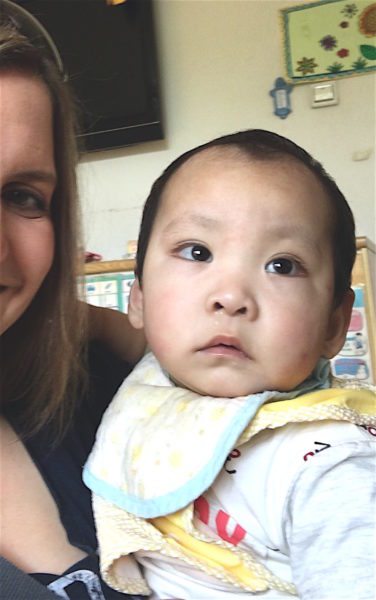Attachment. Not much more could not be packed into one single word, especially in the adoption world.
We spent all of July focusing on this most-important topic and decided to continue into August – but with a bit of a twist.
This month, we’re answering your attachment questions. Because we all have them – we just don’t always have a safe place to ask.

Question: We adopted a very delayed almost 2-year-old. He has multiple health issues and suffers from extreme neglect. Lots of times, he cries, and just wants to be put in his crib and left alone. What can be done to help except more love and time?
I was in your shoes just 14 months ago. We adopted a 16 1/2 month old with global delays and several undiagnosed health issues. My husband and I were both a little shocked at how delayed he was. We had adopted a one year old just a year before, and his very minor delays were, in retrospect, very insignificant, and he caught up quickly to age appropriate milestones on the developmental lists.
Although we knew to expect delays, we were still quite surprised and saddened when the developmental psychologist at our international adoption clinic placed our newest baby on the 6-9 month level after his assessment.
We realized in country that Caston had a host of sensory issues. Water absolutely terrified him. Just hearing the faucet turn on was a trigger. Wind sent him into a fit of terror. He jumped at noises (and we found out later that he has some degree of hearing loss). Still, the hair dryer caused hysteria. And he didn’t want to be touched. I put him in the Ergo carrier, and as I rubbed the top of his little head, he wailed. Our poor baby had a fear of, well… everything.

These early days of adjustment and attachment are so hard! I’ll share some things that helped me get through these challenges.
1. Acknowledge your lack of knowledge.
You may be a seasoned parent who already has a wealth of knowledge and experience with other children, or you may be a first time parent. We had four other children (three bio and one adopted) when we added Caston to our family. We had never experienced any of the fear and sensory issues.
The truth is that we had, cumulatively, 1 1/2 minutes of videos and about 15 pictures in addition to his referral. Those brief snapshots of his life actually told us nothing about his day to day life. He had feeding issues that required us to seek feeding therapy.
Did he have a food-related traumatic experience, or was he simply never exposed to anything besides a bottle? We won’t ever know. Based on his behaviors, we have discerned that he probably lay flat on the floor or crib to take his bottle, and he held it himself, which is why he initially resisted being cradled during feedings.
Was he bathed regularly, or did he just get wiped down daily? Maybe he had never been submerged to the waist in water, and he didn’t know what these crazy new people were trying to do to him. Every day and every fearful crying episode was a trial and error of what helped and what made the situation worse.
2. Treat your new kiddo like a newborn.
At least in your own head. It became easier for me to accept feeding challenges when I didn’t think of my son as a 20 month old, but rather a 4 month old (the length of time he had been in our family). During the particularly challenging times, I still imagine him as a tiny baby who needs me, rather than viewing him as the 2 1/2 year old that is mid-tantrum.
3. Choose playful activities that promote attachment.
Play peek a boo with a blanket. This will not only expose him to the sensory experience of the blanket rubbing against his face which might ease the resistance to you touching his face, but it also provides eye contact in a playful manner. It also is a quick repetitive reminder that even if Mommy is out of sight, she comes back, which helps build trust. You can also have him go down a baby slide and catch him at the bottom. This is reinforcing all of the above in terms of attachment and touch, and it also helps with his gross motor skills.
4. Let him blossom in his own time.
This one has been a big challenge for me. I am a task-master. I love checking off lists. I love intensely researching and coming up with a solution to a problem. But that is not Caston’s personality. He is a slow and steady guy who thrives on a predictable routine. For example, it took 49 consecutive nights of baths before he expressed anything more than mere tolerance. (And this was a huge improvement from the early days when I stood fully clothed in the tub with him so he wouldn’t go underwater from all his screaming and flailing in protest.) And this past week? We were at a pool, and he was happily swimming around in a puddle jumper as his siblings splashed around him. The same was true for his feeding progress. When I felt defeated from the lack of visible improvement, Caston was making progress, at least mentally. The repeated exposure may not have resulted in eating at the time, but it did result in a higher level of comfort for him.
5. Keep him close.
The Ergo (or any other toddler carrier) was a lifesaver me. If I was cooking or cleaning, my babies could still be right up next to me to feel safe. I will admit that with our sensory kiddo, the carrier was tough at first. He resisted it because he didn’t like to be held. However, in China, it was a necessity, so we toughed it out, and he was eventually at least tolerant of the idea of baby wearing. He grew to love it, and it became our routine for him to ride on my back in the carrier at home. After 14 months home, he still sleeps in a pack n play in our room at night.
6. Make life predictable.
Routines are important. In addition, we coupled songs and signs with every activity. We made up a bath song, a tooth brushing song, an eating song, a diaper changing song, bedtime song, etc. You can also connect the signs with visual cues such as flash cards to show the upcoming activity such as bath or bottle feeding.
7. Reminisce. Look back on your pictures and videos of the first days with your child. You will certainly notice the changes and progress he has made. We often marvel at our 2 1/2 year old consuming an entire hamburger, fries, and fruit at a meal when just one year ago, I cried tears of joy because he put a single goldfish cracker in his mouth. And now, he eats it all and signs to ask for a cookie or cake!
It’s easy (and very understandable) to feel discouraged right now. One of my friends said that the early days are like babysitting a kid whose parents never show back up to get her. But with time and focused attention on attachment, you and your child will ease into your new norm. I would say that with the addition of each child to our family, it takes about a year until things start to feel “normal.” If, however, you don’t see progress after several months, it is always wise to consult a therapist that specializes in adoption and attachment.


























Leave a Reply